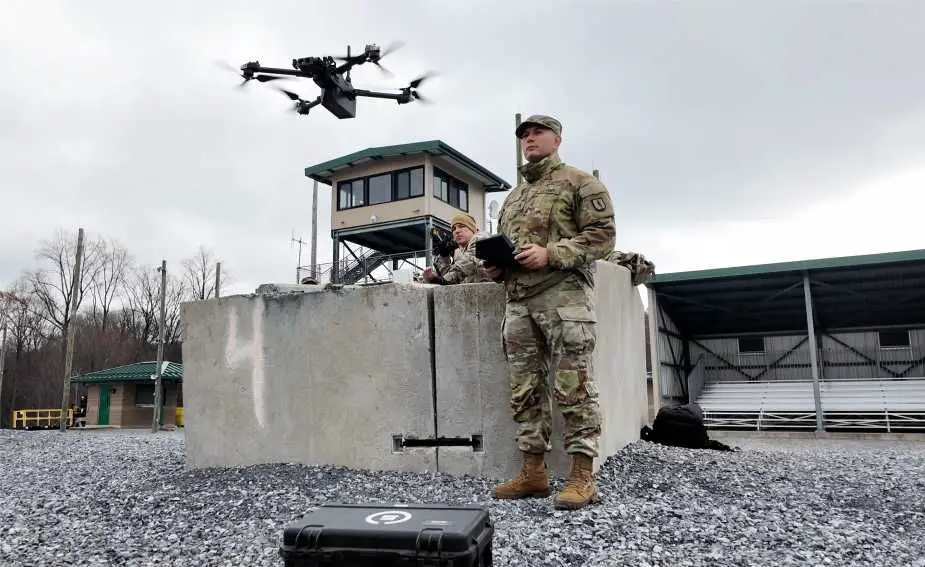Breaking News
US Army Develops New Artillery Tactics Using Reco Drones from Experience Gained in Ukraine.
In response to the evolving dynamics of modern warfare, particularly lessons drawn from the Ukraine conflict, the U.S. Army has intensified the integration of Small Unmanned Aircraft Systems (SUAS) into its artillery operations. This strategic enhancement aims to bolster target acquisition accuracy and streamline artillery fire missions.
Follow Army Recognition on Google News at this link

U.S. Army M109A6 Paladin self-propelled howitzer fires on a precision target identified by a drone operator, showcasing advanced coordination between artillery and reconnaissance drones for enhanced battlefield effectiveness. (Picture source: U.S. DoD)
Forward observers from the 1st Battalion have deployed various SUAS (Small Unmanned Aircraft Systems ) models to gather precise targeting data on identified threats. These drones provide real-time intelligence, enabling observers to relay accurate coordinates and situational information to artillery units. This capability significantly reduces the time between target detection and engagement, enhancing operational efficiency.
Utilizing the targeting data acquired by SUAS, soldiers from the 2nd Battalion have effectively engaged targets using a range of artillery platforms. These include the M119 Howitzer, a lightweight, towed 105mm howitzer known for its mobility and rapid deployment capabilities; the M777 Howitzer, a 155mm towed artillery piece renowned for its precision and extended range, offering substantial firepower in various combat scenarios; and the M109A6 Paladin, a self-propelled 155mm howitzer that combines mobility with advanced targeting systems, providing sustained fire support on the battlefield. The integration of SUAS with these artillery systems has demonstrated a marked improvement in the accuracy and responsiveness of fire missions.
The conflict in Ukraine has significantly highlighted the transformative role of drones in modern artillery operations. Both Ukrainian and Russian forces have extensively utilized unmanned aerial vehicles (UAVs) to enhance the accuracy and effectiveness of their artillery systems.
Ukrainian forces have effectively integrated drones into their artillery units to improve target acquisition and fire accuracy. By employing various UAVs, including first-person-view (FPV) drones, they have been able to conduct real-time reconnaissance, identify enemy positions, and adjust artillery fire accordingly. This integration has led to a significant increase in the precision of artillery strikes, allowing Ukrainian forces to engage targets with greater efficiency and reduced collateral damage. Notably, Ukrainian drone units are reported to be responsible for inflicting up to 80% of frontline casualties on Russian forces, underscoring the critical role of drones in their military strategy.
Similarly, Russian forces have leveraged drones to enhance their artillery operations. The use of UAVs has enabled Russian artillery units to conduct effective counter-battery fire and improve the accuracy of their strikes. For instance, the ZALA Lancet loitering munition has been employed to target Ukrainian artillery systems, including self-propelled howitzers and air defense systems. As of October 2023, Russia conducted a total of 667 Lancet strikes on various Ukrainian weaponry, with nearly half of these engagements focusing on artillery installations.

Forward observers from the 1st Battalion deploy Small Unmanned Aircraft Systems (SUAS) to gather precise targeting data, relaying critical information to the howitzer crew for accurate and effective artillery strikes. (Picture source U.S. DoD)
Integrating drones into artillery operations has led to a paradigm shift in battlefield tactics. Traditional methods of artillery targeting, which often relied on manual calculations and static observation posts, have been augmented by real-time data provided by drones. This advancement allows for rapid adjustments to firing solutions, increasing the likelihood of first-round hits and reducing the need for prolonged bombardments. Additionally, drones have facilitated effective counter-battery operations by quickly locating enemy artillery positions, enabling prompt retaliatory strikes.
The widespread use of drones has also necessitated the development of counter-drone measures. Both Ukrainian and Russian forces have employed electronic warfare systems to jam or disrupt enemy UAVs. Physical countermeasures, such as anti-aircraft systems and small arms fire, have neutralized drones. The ongoing technological race in drone and counter-drone capabilities continues to evolve, influencing the tactics and strategies employed by both sides.
In summary, the conflict in Ukraine has underscored the pivotal role of drones in modern artillery operations. The integration of UAVs has enhanced the accuracy and effectiveness of artillery strikes, leading to significant tactical advantages on the battlefield. As drone technology continues to advance, its impact on artillery tactics and overall military strategy is likely to grow, shaping the future of warfare.
Looking ahead, the U.S. Army plans to expand the deployment of SUAS across various units, emphasizing comprehensive training programs to ensure proficiency in drone operations and data integration. This initiative aligns with the broader objective of modernizing artillery tactics to meet the demands of contemporary warfare. By leveraging the capabilities of SUAS (Small Unmanned Aircraft Systems), the U.S. Army aims to maintain a tactical advantage, ensuring that artillery units can deliver precise and effective fire support in diverse operational environments.


























